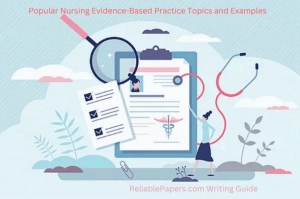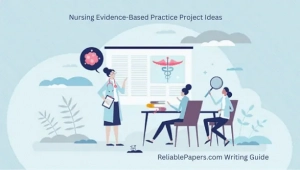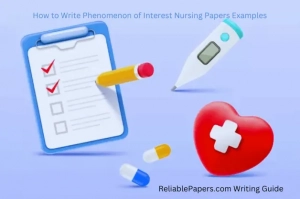Nursing Evidence-Based Practice Topics and Examples

Nursing evidence-based practice (EBP) is a problem-solving approach that combines the best available evidence, clinical expertise, and patient values and preferences to make informed healthcare decisions. EBP is used to improve patient outcomes, enhance the quality of care, and reduce the risk of adverse events. EBP focuses on delivering high-quality patient care while reducing healthcare costs and variations in patient outcomes.
There has been a consistent worldwide increase in the use of evidence-based practice among nurses. As a result, there is a greater demand for research, and educators are increasingly giving their student’s research paper assignments in this area. If you can’t think of a good topic, don’t worry—this article has the most recent evidence-based practice nursing research topics.
How to Choose Nursing Evidence-Based Practice Research Topics
To select nursing evidence-based practice research topics, it is helpful to brainstorm what topic is the best choice for you. Consider whether your instructor has already provided a topic or not. If not, look for research that has been done and narrow your topic to be more specific. You can also consider a particular health issue that interests you and drew you to the profession. Additionally, browse the table of contents of the publication Nation’s Health in the FGCU Library’s eJournals for ideas.
Once you have jotted down a few topics, conduct a preliminary literature search in a database such as CINAHL or Proquest Health & Medical. Alternatively, look in the FGCU Library’s catalog for books related to your topic. It is important to keep in mind that research topics are not set in stone, and choosing a research topic is not always straightforward. As you begin to look for articles on your initial topic, your research idea may change.
You can also get ideas for evidence-based practice nursing research topics from many sources available at your disposal, such as Evidence-Based Practice Toolkit for Nursing. Additionally, watch this video from NSCU on how to pick a manageable research topic for your assignment. After conducting a review of relevant literature, use filters and hedges such as the Population, Intervention, Comparison, Outcome (PICO) format when searching systematic reviews and randomized controlled trials in the PubMed or CINAHL databases. Lastly, in the CINAHL search options, choose Evidence-Based Practice sources and use words or phrases from subject terms or abstracts of relevant articles to find more information about your chosen topic.
Where to Get Nursing Evidence-Based Practice Topics Ideas
There are several sources where you can find ideas for nursing evidence-based practice (EBP) topics:
- Course readings and class notes: Reviewing course readings and class notes from your nursing program can provide a solid foundation for your EBP research. This material can help you understand the basics of nursing EBP and provide inspiration for topics you can pursue.
- Library resources: Your university library is an excellent resource for finding information on nursing EBP topics. You can access academic journals, books, and databases that contain the latest research and information in nursing. You can also talk to a librarian for guidance on finding relevant resources.
- Research guide provided by your professor: Your professor may have a research guide or a list of recommended resources for finding EBP topics. This can provide a focused starting point for your research.
- Online references: There are many online resources available for finding EBP topics, including academic journals, databases, and websites. You can use search engines, such as Google Scholar, to find relevant articles and studies on nursing EBP topics.
- Encyclopedias and nursing books: Encyclopedias and nursing books are great sources for background information and context on various nursing EBP topics. They can provide you with a broad understanding of the field and help you identify areas that warrant further research.
- Professional organizations: Professional organizations, such as the American Nurses Association (ANA) and Sigma Theta Tau International Honor Society of Nursing, offer resources and information on current trends and challenges in nursing practice. These organizations often have journals, newsletters, and conferences that highlight recent research and current topics in EBP.
- Research databases: Search research databases, such as PubMed, CINAHL, and Cochrane Library, to find recent studies and articles on nursing EBP topics. Look for articles that address clinical issues or questions that are relevant to your area of interest.
- Clinical practice guidelines: Review clinical practice guidelines and recommendations from organizations such as the National Institute for Health and Care Excellence (NICE) and the Centers for Disease Control and Prevention (CDC). These guidelines can provide a starting point for your EBP topic selection.
- Clinical settings: Observe and talk to nurses in your clinical setting to identify areas of practice that would benefit from further research and improvement.
- Online forums and discussion boards: Online forums and discussion boards, such as nursing discussion groups on social media, can provide a wealth of information and ideas for EBP topics. You can engage with other nurses and researchers to get their perspectives and insights on current challenges and opportunities in nursing practice.
Remember, it’s important to choose a topic that is relevant, feasible, and has the potential to make a meaningful contribution to the field of nursing. The above sources can provide a starting point for your EBP topic selection, but it’s important to carefully evaluate the potential impact and feasibility of each topic before making a final decision.
In another article written by our experts, you read the guide on how to write nursing term papers to assist you with your writing.
A Sample List of Evidence-Based Practice Topics for Nursing Students
- Understanding evidence-based practice in nursing: definition, process, and implementation
- The role of critical appraisal in evidence-based practice
- Why is Evidence Based Practice Important in Healthcare?
- Evidence-based practice and patient outcomes: impact, effectiveness, and outcomes measurement
- Incorporating patient preferences and values in evidence-based practice
- The Crucial Role of Nurses in Medication Management
- Interprofessional collaboration and evidence-based practice
- Remote collaboration and evidence-based care
- Evidence-based practice and quality improvement in nursing
- Advancing nursing practice through technology: telehealth, mHealth, and other innovative solutions
- Evidence-based pain management in nursing
- Evidence-based approaches to falls prevention in older adults
- Evidence-based practices on adult-gerontology acute care
- Evidence-based pressure ulcer prevention and treatment
- Infection control and prevention in healthcare: evidence-based practices
- Evidence-based medication management in nursing
- Cardiovascular health: evidence-based practices for prevention and management
- Evidence-based diabetes management in nursing
- Mental health and depression: evidence-based practices and interventions
- Chronic obstructive pulmonary disease (COPD) management: evidence-based practices
- Evidence-based asthma management in nursing
- Theoretical foundations of nursing: applying psychosocial theories
- Substance abuse and addiction: evidence-based approaches to treatment and recovery
- Palliative care and end-of-life support: evidence-based practices
- Cancer care and treatment: evidence-based practices for quality improvement
- Pediatrics and child health: evidence-based practices for assessment and care
- Maternal and newborn health: evidence-based practices for care and outcomes
- Women’s health: evidence-based practices for prevention and management
- Men’s health: evidence-based practices for prevention and management
- Geriatrics and Aging: evidence-based practices for care and quality of life
- Sleep disorders: evidence-based practices for assessment and management
- Nutrition and weight management: evidence-based practices for health and wellness
- Chronic kidney disease management: evidence-based practices for care and outcomes
- Physical therapy and rehabilitation: evidence-based practices for recovery and function
- Respiratory therapy: evidence-based practices for assessment and management.
- Advancing nursing practice through technology
- Discussion on the examples of evidence-informed nursing practice protocols
- A nurse’s impact on advocacy and policy
- Advancing patient safety through technology
- Racism and nurses: diverse perspectives
- Intervention and health promotion plan for diverse population
- Motivational interviewing and stroke patients
- Telephone-based care and early detection of depression and anxiety in post-coronary patients
- Noninvasive technologies for diagnosing coronary artery disease in women: comparative effectiveness
- Understanding evidence-based practice in nursing + 10 examples
- Benefits of evidence-based practice in nursing
- A team approach to evidence-informed practice in nursing
- Improving the cardiac health of your patients
- Radiofrequency ablation for atrial fibrillation: clinician’s guide
- ACEIs, ARBs, or DRI for adults with hypertension
- Addressing disabilities in healthcare
- Endocrinology Discussion: Pituitary Gland
- Assessing the Health Problem: Leadership Collaboration Communication Change Management and Policy Considerations
- Analyzing a current healthcare problem or issue
- Managing a toxic Leader in a healthcare environment
These are just a few examples of nursing EBP topics. The focus of EBP can vary depending on the needs and priorities of a specific patient population or healthcare setting.
Current and Good Evidence-Based Practice Topics for Nursing
- Pain management: Effective strategies for reducing pain in patients, such as the use of non-pharmacologic approaches, such as massage and relaxation techniques, and the appropriate use of pharmacologic interventions.
- Patient safety: Interventions to prevent errors and adverse events in the healthcare setting, such as hand hygiene, adverse drug event prevention, and the use of checklists to improve communication among healthcare providers.
- Infection control: Strategies for preventing the spread of infections in healthcare settings, including the proper use of personal protective equipment (PPE), hand hygiene, and environmental cleaning.
- Chronic disease management: Interventions for managing chronic conditions such as diabetes, heart disease, and chronic obstructive pulmonary disease (COPD), including lifestyle modifications, medication management, and disease self-management programs.
- Patient education: Effective approaches for educating patients about their health and their care, such as the use of patient-centered, culturally appropriate health communication and decision-making tools.
- Evidence-based treatment guidelines: The development and implementation of treatment guidelines based on the best available evidence, such as guidelines for the management of acute pain or the use of antibiotics in wound management.
- Quality improvement: Strategies for improving the quality of care in healthcare organizations, including the use of data and performance measurement to identify areas for improvement and the implementation of evidence-based practices.
- Quadruple Aim and Evidence-Based Practice: Explore innovative approaches to achieve the Quadruple Aim, emphasizing patient experience, population health, cost reduction, and healthcare team well-being. Topics include enhancing communication, teamwork, and stress management to optimize healthcare outcomes and provider satisfaction.
Master of Science in Nursing (MSN) Nursing Evidence-Based Practice Topics
- Evidence-based teaching methods in nursing education: Strategies for incorporating evidence-based teaching methods into MSN programs, including the use of simulation, case studies, and other educational techniques.
- Interprofessional education in nursing: Evidence-based approaches for promoting interprofessional education in MSN programs, including the use of team-based learning, collaborative care models, and other techniques.
- Use of technology in nursing education: Evidence-based approaches for incorporating technology into MSN programs, including the use of online learning, virtual simulations, and other digital tools.
- Evaluation of MSN programs: Evidence-based methods for evaluating the effectiveness of MSN programs, including the use of outcomes assessment, student satisfaction surveys, and other evaluation techniques.
- Faculty development in nursing education: Evidence-based strategies for supporting the professional development of faculty in MSN programs, including the use of mentoring, coaching, and other support mechanisms.
- Curriculum design in MSN programs: Evidence-based approaches for designing MSN programs that are responsive to the changing needs of healthcare, including the use of competency-based education and other innovative curriculum design techniques.
- Student engagement and retention in MSN programs: Evidence-based strategies for promoting student engagement and retention in MSN programs, including the use of active learning, student-centered teaching, and other techniques.
- Simulation-based education in nursing: Evidence-based approaches for incorporating simulation into MSN programs, including the use of high-fidelity simulations, low-fidelity simulations, and other techniques.
Nursing Evidence-Based Practice Topics emergency room (ER) Care Related
- Pain management in the emergency room: Effective strategies for reducing pain in patients who present with acute conditions in the ER, such as fractures or lacerations.
- Sepsis recognition and management: Evidence-based strategies for early recognition and treatment of sepsis, a potentially life-threatening condition, in the ER setting.
- Management of acute myocardial infarction (AMI): Best practices for managing patients who present with symptoms of a heart attack, including the use of thrombolytics and other evidence-based interventions.
- Triage of patients with chest pain: Evidence-based protocols for accurately triaging patients who present with chest pain, including the use of electrocardiography (ECG) and other diagnostic tests.
- Management of patients with suspected stroke: Evidence-based strategies for the rapid evaluation and treatment of patients who present with symptoms of a stroke, including the use of thrombolytics and other evidence-based interventions.
- Care of patients with head injuries: Evidence-based protocols for the evaluation and management of patients with head injuries, including the use of computed tomography (CT) scans and other diagnostic tests.
- Pain management in trauma patients: Effective strategies for reducing pain in trauma patients, including the use of medications and other non-pharmacologic interventions.
- Management of acute alcohol withdrawal: Evidence-based protocols for managing patients who present with symptoms of alcohol withdrawal, including the use of medications and other evidence-based interventions.
Nursing Evidence-Based Practice Topics for Surgical Care Related
- Preoperative assessment and preparation: Evidence-based protocols for performing preoperative assessments and preparing patients for surgery, including the use of preoperative fasting, skin preparation, and other interventions.
- Perioperative pain management: Effective strategies for reducing pain during and after surgery, including the use of regional anesthesia, patient-controlled analgesia, and other pharmacologic and non-pharmacologic interventions.
- Prevention of surgical site infections: Evidence-based strategies for reducing the risk of surgical site infections, including the use of prophylactic antibiotics, wound dressings, and other interventions.
- Management of patients with chronic pain undergoing surgery: Evidence-based protocols for managing patients with chronic pain who are undergoing surgery, including the use of preoperative pain management techniques, postoperative pain management strategies, and other interventions.
- Postoperative management and discharge planning: Evidence-based protocols for managing patients after surgery and planning for their discharge from the hospital, including the use of pain management techniques, rehabilitation, and other interventions.
- Enhanced recovery after surgery (ERAS) programs: Evidence-based protocols for implementing ERAS programs, which are designed to optimize patient outcomes and reduce complications after surgery.
- Management of patients with comorbidities undergoing surgery: Evidence-based protocols for managing patients with comorbidities, such as diabetes, heart disease, or respiratory disease, who are undergoing surgery, including the use of perioperative glucose control, blood pressure management, and other interventions.
- Management of patients with bleeding disorders undergoing surgery: Evidence-based protocols for managing patients with bleeding disorders, such as hemophilia, who are undergoing surgery, including the use of prophylactic medications and other interventions.
Critical Care Nursing Evidence-Based Practice Topics
- Ventilator-associated pneumonia (VAP) prevention: Evidence-based strategies for preventing VAP in mechanically ventilated patients, such as elevating the head of the bed, oral care, and appropriate sedation management.
- Sepsis management: Evidence-based approaches for the early recognition and management of sepsis, including the use of quick sepsis-related organ failure assessment (qSOFA) scores and timely administration of antibiotics.
- Hemodynamic monitoring: Evidence-based practices for monitoring and optimizing the hemodynamic status of critically ill patients, such as the use of invasive and non-invasive hemodynamic monitoring techniques and the interpretation of blood pressure and cardiac output data.
- Pain management in critically ill patients: Evidence-based strategies for managing pain in critically ill patients, including the use of non-pharmacologic approaches, such as repositioning, and the appropriate use of pharmacologic interventions, such as opioids.
- Critical care delirium: Evidence-based interventions for preventing and managing delirium in critically ill patients, including the use of non-pharmacologic approaches, such as environmental modifications, and the appropriate use of pharmacologic interventions, such as antipsychotics.
- Acute respiratory distress syndrome (ARDS): Evidence-based strategies for managing ARDS, including the use of low tidal volume ventilation and prone positioning.
- Nutrition in critical care: Evidence-based approaches for providing optimal nutrition support to critically ill patients, including the use of enteral and parenteral nutrition, and the appropriate timing and dosing of micronutrient supplementation.
- Family-centered care in critical care: Evidence-based approaches for involving families in the care of critically ill patients, including the provision of emotional support and access to information, and the implementation of family-centered rounds.
Nursing Evidence-Based Practice Topics Trauma Care Related
- Trauma triage: Evidence-based approaches for rapidly and accurately triaging trauma patients, including the use of trauma scoring systems and the implementation of triage protocols.
- Hemorrhage control: Evidence-based strategies for controlling bleeding in trauma patients, including the use of tourniquets, hemostatic dressings, and minimally invasive techniques, such as embolization.
- Traumatic brain injury (TBI): Evidence-based interventions for managing TBI, including the use of mild therapeutic hypothermia, pharmacologic treatments, and rehabilitation.
- Spinal cord injury: Evidence-based approaches for managing spinal cord injury, including the use of immobilization techniques, surgical intervention, and rehabilitation.
- Burns: Evidence-based strategies for the management of burn injuries, including wound care, fluid resuscitation, and pain management.
- Blast injuries: Evidence-based interventions for managing blast injuries, including the use of tourniquets, wound care, and the management of associated injuries, such as hearing loss and eye injuries.
- Trauma-induced coagulopathy: Evidence-based strategies for preventing and managing trauma-induced coagulopathy, including the use of point-of-care coagulation testing and the administration of blood products.
- Psychological interventions for trauma patients: Evidence-based approaches for addressing the psychological needs of trauma patients, including the use of trauma-focused cognitive-behavioral therapy and trauma-focused psychotherapy.
Final Remarks on Nursing Evidence-Based Practice Topics and Examples
Evidence-based practice (EBP) is an important part of nursing practice, as it involves using the best available evidence to make decisions about patient care. EBP has had a great impact on the nursing profession, leading to improved patient outcomes and cost savings. It has also enabled nurses to conduct research to improve their practice and develop new procedures that save time and resources for both patients and healthcare providers.
EBP requires nurses to have adequate skills and knowledge in order to implement it effectively. This includes understanding the definition of healthcare quality, being able to identify relevant evidence, and having the ability to interpret research findings. The Institute of Medicine (IOM) has urged each profession to develop strategies for integrating EBP competencies into education in order to ensure that nurses are adequately prepared for their roles.
In conclusion, evidence-based practice is essential for nursing students worldwide. It has had a great impact on the nursing profession, leading to improved patient outcomes and cost savings. Nurses must have adequate skills and knowledge in order to implement EBP effectively, which can be achieved by incorporating EBP competencies into education.
Using this resource, you can more easily identify relevant questions to investigate in the field of evidence-based practice nursing. Check the suggestions provided above and pick something that both fascinates you and will hold your reader’s attention. Think outside the box. You have the ability to identify excellent research topics.
Get Nursing Evidence-Based Practice Writing Services from Experts
ReliablePapers.com offers the best nursing evidence-based practice paper writing services.
When you hire us, we’ll assign you writers who can help you narrow down possible topics until you find one that’s doable and meets your paper’s purpose.
Finding a reliable custom writing service to do your nursing evidence-based practice paper requires you to think carefully about a number of things, such as the writer’s experience and the guarantee that your work will be done to your satisfaction.
Contact our essay writing service anytime for assignment assistance. We have put together an unbeatable team by hiring only the most talented and hard-working writers.
We assist with nursing evidence-based practice project papers and other difficult assignments.
Our low prices and quick turnaround times have helped us gain the trust of many students.
Hire an Expert Paper Writer on Any Subject, Any Topic, Any Deadline! Submit your paper instructions by placing your order here to get started!












